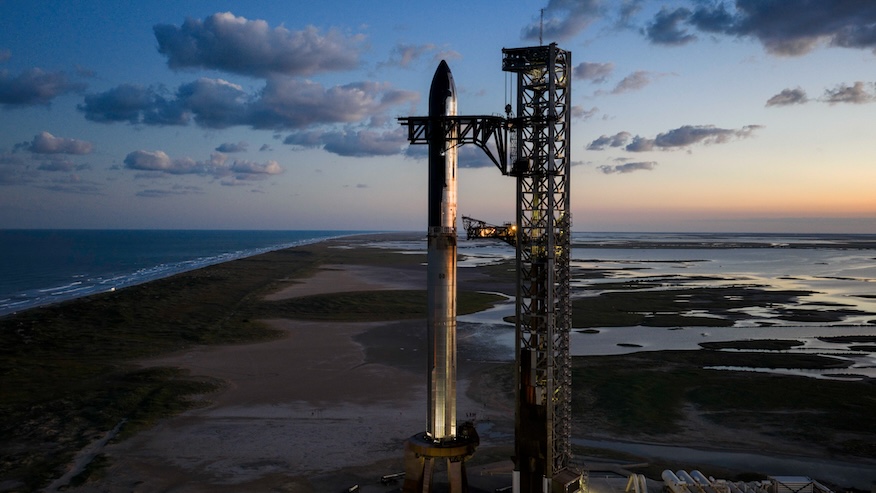
SpaceX is preparing for a notable flight for its Starship program. The company is scheduled to launch its Starship-Super Heavy rocket from its headquarters in Starbase, Texas, on Monday evening.
The 11th flight test of the integrated Starship launch vehicle will be the final mission both for the Version 2 iteration of the rocket as well as the current configuration of Pad A. SpaceX is targeting liftoff at 6:15 p.m. CDT (7:15 p.m. EDT / 2315 UTC).
Spaceflight Now will have live coverage beginning about two hours prior to takeoff.
On Sunday evening, SpaceX said the weather outlook was 80 percent favorable, but didn’t elaborate on the specifics of the meteorological constraints.
Starship Flight 11 will use the Super Heavy booster with the tail number B15. It’s making its second flight following the launch and catch SpaceX achieved during Flight 8 in March.
That was the third booster that SpaceX has caught with the launch tower at Pad A, nicknamed ‘Mechazilla’, following successful catches during Flight 5 and Flight 7. SpaceX will reuse 24 out of the 33 Raptor 2 engines on B15 during the Flight 11 mission.
Following the hot-staging maneuver to separate Starship (S38) from B15 about 2.5 minutes into the mission, the booster will perform a new engine configuration during the landing burn as it targets an aquatic landing off shore.
B15 will begin the burn with the 13 middle and center engines and then transition down to five engines, instead of three.
“Previously done with three engines, the planned baseline for V3 Super Heavy will use five engines during the section of the burn responsible for fine-tuning the booster’s path, adding additional redundancy for spontaneous engine shutdowns,” SpaceX said ahead of the launch.
Like with the Flight 10 mission, SpaceX will attempt to deploy eight steel structures meant to replicate the size and mass of future Starlink Version 3 satellites. Given this is a suborbital flight, the Starlink simulators will follow a similar trajectory and end up in the Indian Ocean.
SpaceX will also attempt a relight of one of the sea-level Raptor engines during the coast phase of S38. This is meant to demonstrate that future versions of Starship can safely deorbit themselves following a mission as well as raise their orbit before deploying a payload.
More than an hour after liftoff, S38 will target a water landing in the Indian Ocean off the coast of Australia.
SpaceX intentionally removed heat shield tiles to learn more about the stress points of the vehicle. It will also be working to learn more about the type of flight maneuvers needed for future orbital flights where Starship would be returning to Starbase.
“To mimic the path a ship will take on future flights returning to Starbase, the final phase of Starship’s trajectory on Flight 11 includes a dynamic banking maneuver and will test subsonic guidance algorithms prior to a landing burn and splashdown in the Indian Ocean,” SpaceX said.
SpaceX plans to have this be the final launch of 2025 for the Starship program. It will spend the next few to several months in finalizing Starship Version 3, which is intended to be the iteration that can perform orbital launches and recoveries.
It’s also moving operations to Pad B, which has been under construction for nearly two years. One of the most distinctive features of this new launch site is the construction of a more traditional flame trench, which was not incorporated into the Pad A initial design.
William Gerstenmaier, SpaceX Vice President of Build and Flight Reliability, said that SpaceX plans to launch at least one suborbital flight of Starship Version 3 before attempting an orbital flight.
source: spaceflightnow.com